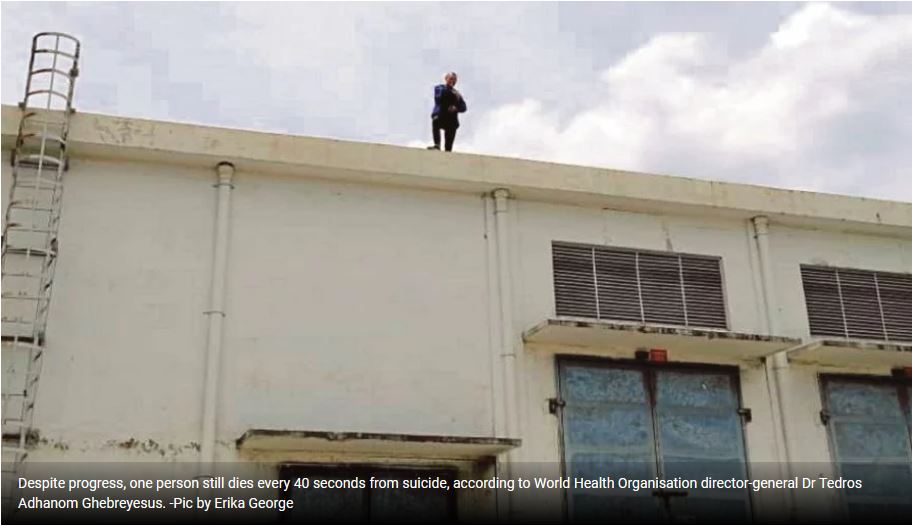Tackling suicidal tendencies
Emeritus Professor Tan Sri Dato' Dzulkifli Abdul Razak
Opinion - New Straits Times
September 13, 2019
AT the International Islamic University Malaysia on Sept 10 saw a public lecture delivered by the former minister of education of Bhutan on Gross National Happiness, a theme which is relevant and important to the ailing world around us today.
When it comes to issues affecting life, mental health with the threat of increasing suicidal tendencies is becoming prevalent worldwide.
In fact, this was the message that was zeroed in by the organisers of the World Suicide Prevention Day when they launched the “40 seconds of action” campaign “to raise awareness of the scale of suicide around the world and the role that each of us can play to help prevent it”.
In a report by the World Health Organisation (WHO), the number of countries with national suicide prevention strategies has increased in a spate of five years.
However, the total number of countries with strategies totalling 38 is still far too few and governments need to commit to establishing them.
“Despite progress, one person still dies every 40 seconds from suicide,” said WHO director-general Dr Tedros Adhanom Ghebreyesus.
“Every death is a tragedy for family, friends and colleagues. Yet suicides are preventable. We call on all countries to incorporate proven suicide prevention strategies into national health and education programmes in a sustainable way.”
Ironically, the suicide rate is said to be highest in high-income countries and the second leading cause of death among young people. This raises fundamental questions about the state of “happiness” that Bhutan is advocating in earnest relative to materialistic measures like Gross Domestic Product (GDP) or, in today’s context, better described as “Gross Distortion of Prosperity” — to quote the late Senator Robert Kennedy.
Furthermore, nearly three times as many men compared with women die by suicide in high-income countries in contrast to low and middle-income countries, where the rate is apparently more equal (so much for gender equality.) More troubling still is that suicide was the second leading cause of death among young people aged between 15 and 29, after road injury.
Among teenagers aged 15 to 19, suicide was the second leading cause of death among girls (after maternal conditions) and the third leading cause of death in boys (after road injury and interpersonal violence).
On the home front, based on the Health Ministry’s National Health and Morbidity Study, “suicide among teenagers aged 13 to 17 is on an upward trend, with thoughts of suicide rising from 7.9 per cent in 2012 to 10 per cent in 2017”.
Also trending upward is “the prevalence of suicidal planning among youths, rising from 6.4 per cent in 2012 to 7.3 per cent in 2017, while suicide attempts also increased from 6.8 per cent in 2012 to 6.9 per cent in 2017,” quoting the Health director-general Datuk Dr Noor Hisham Abdullah in the World Suicide Prevention Day address last week.
“For each victim, it is estimated that 20 family members or friends will (also) experience an emotional, social and economic impact,” he said.
Dr Chan Lai Fong, the Malaysian national representative to the International Association of Suicide Prevention and a consultant psychiatrist, suggested that the “two recent student suicides” have something to do with education, in particular, exams and homework that can cause unwarranted pressure.
This brings to mind a study in Penang which showed that close to 20 per cent of students were found to experience “depression” with some six per cent contemplating suicide.
That education is implicated is not surprising in this part of the world where suicidal issues have been a major concern in countries like South Korea, Japan, Hong Kong and China with Singapore joining in the league.
Malaysia will be a likely candidate if we choose to blindly follow the so-called “Asian tiger mum” model. Our own tragedy of the Instagram-induced suicide in Sarawak not too long ago could be an ominous sign of things to come.
Bearing in mind that the factors are often complex and multidimensional, the solutions therefore are beyond any single idea (anti-bullying, anti-sexual harrasment, CyberPatrol parental control software, etc) including “reforming” this and the other in an ad hoc manner in a reactive way as is often the case.
As such, as we draft the 12th Malaysia Plan, suicides must be uppermost in our mind to nurture a robust and humane generation of the future. It must be about the entire Malaysian society coming together to create a connected whole which is greater than the sum of its parts.
Only then can issues like suicides and mental health be addressed comprehensively by connecting all the ministries in unison.
The writer, an NST columnist for more than 20 years, is International Islamic University Malaysia rector

